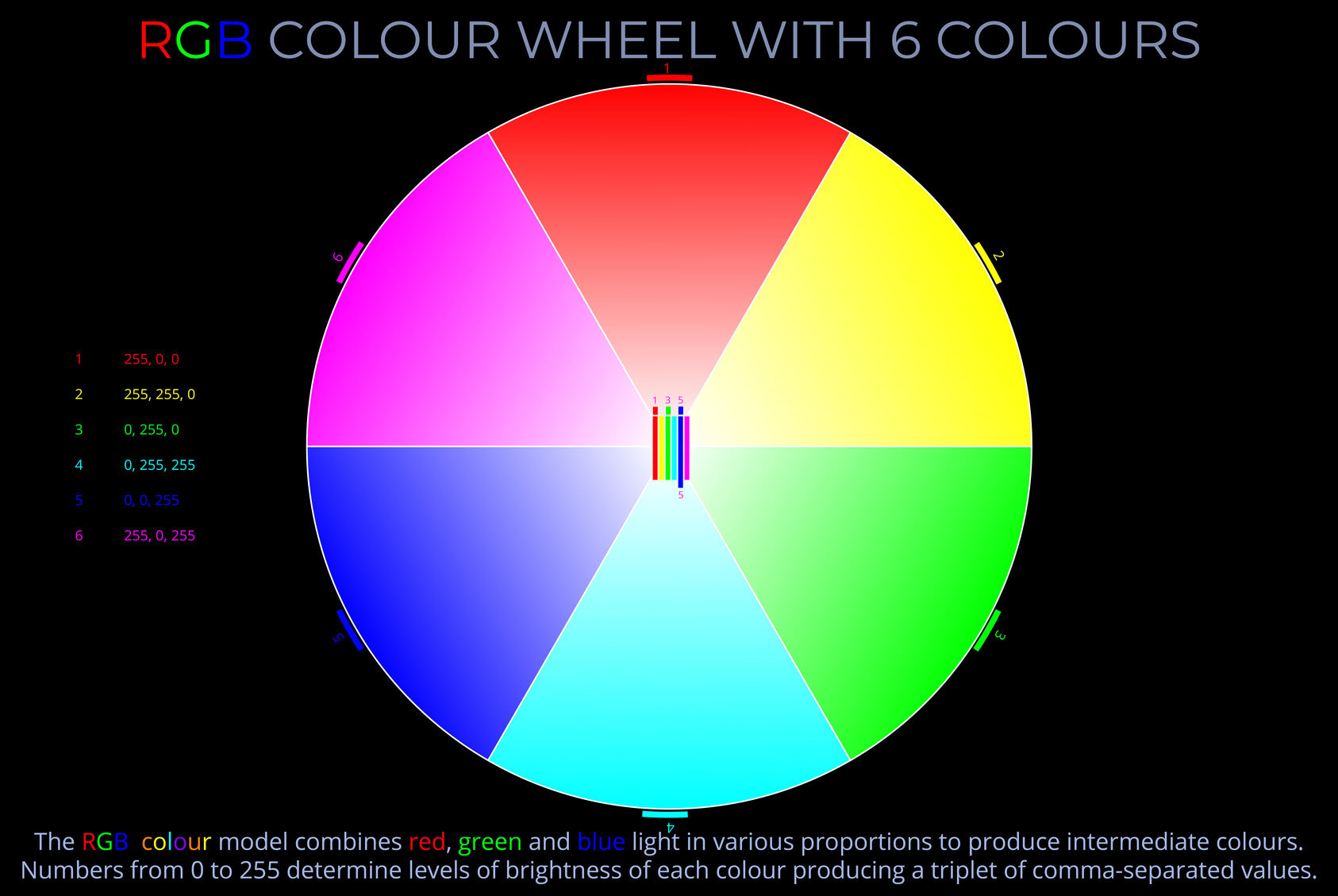A colour wheel is a diagram based on a circle divided into segments and used to explore the effect of mixing adjacent colours.
- A colour wheel is a perceptual tool used to explore a colour model.
- Colour models that use colour wheels include:
- RGB colour model – Used for mixing light.
- RYB colour model – Used for mixing opaque pigments
- CMY colour model – Used for mixing semi-transparent inks.
- Colour wheels are not used to explore the spectral colour model because each colour corresponds with a single wavelength of light rather than mixtures of primary colours.
- The spectral colour model is usually portrayed as a strip of colours with red at one end and violet at the other.
- The minimum number of segments in a colour wheel is three with a primary colour in each.
- Segments between primary colours are used to explore the result of mixing adjacent pairs of primary colours to produce secondary colours.
- Segments between secondary colours can be used to explore the result of mixing further pairs of adjacent colours.
- Wheels of increasing complexity are produced by further subdivisions.
- The colours produced between the primary colours in a colour wheel are called secondary colours.
- The colours produced between the secondary colours are called tertiary colours.
- Colour wheels used to explore additive and subtractive colour models start with different sets of primary colours.
- An RGB colour wheel, used to explore additive mixing of light, starts with red, green and blue primary colours.
- An RYB colour wheel, used to explore subtractive mixing of pigments starts with red, yellow and blue primary colours.
- A CMY colour wheel, used to explore subtractive mixing of printing inks starts with cyan, magenta and yellow primary colours.
About wavelengths of light and colour vision
There is a clear difference between the wavelengths of light that make up the visible spectrum and how the human eye converts the information it receives about wavelength into the perception of colour.
- The human eye, and so visual perception, is tuned to the visible spectrum and so to spectral colours between red and violet.
- It is the sensitivity of the eye to this small part of the electromagnetic spectrum that results in the perception of colour.
- Photosensitive cone cells embedded in the retina of each eye respond to wavelengths of light corresponding with spectral colours.
- Explained in simple terms, cone cells distinguish between different colours by determining how much red, green and blue are present when stimulated by their corresponding wavelengths.
- The system used by the human eye to distinguish colours is called trichromacy or trichromatic colour vision.
- The spread of wavelengths that the spectral colour model is concerned with is well suited to a linear arrangement with the shortest at one and the longest at the other.
- The way the human eye determines colour from the presence of three primary colours (red, green and blue) lends itself to a circular, wheel-like arrangement.
- The RGB color model used in digital displays and imaging devices is based on the trichromatic nature of human vision.
No posts found.
References
- A colour wheel is a circular diagram divided into segments, featuring primary colours, and used to visualize the result of colour mixing.
- Colour wheels can enhance understanding of colour relationships and assist with the accurate selection and reproduction of colours.
- A colour wheel starts with segments representing primary colours. Additional segments are added between them to explore the outcome of mixing adjacent primary colours.
- By adding more segments between existing ones, further mixing of adjacent colours can be explored.
- A colour wheel exploring the additive RGB colour model starts with red, green, and blue primary colours.
- A colour wheel exploring the subtractive CMY colour model starts with cyan, magenta, and yellow primary colours.



